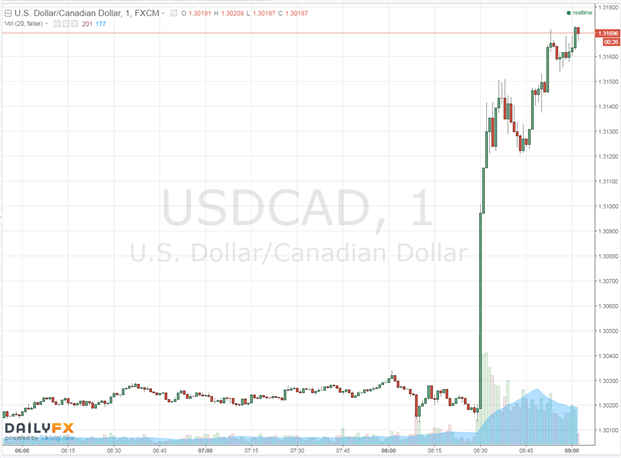Talking Points:
- July Canadian employment falls by -31.2K, significantly below expecations of a gain of +10.0K.
- July Canadian jobless rate rises to 6.9% from 6.8%, in line with market consensus.
- Avoid the pitfalls of trading by steering clear of classic mistakes. Review these principles in the "Traits of Successful Traders" series.
Canada’s labor market decelerated sharply in July after a dismal performance in June, Statistics Canada reported Friday. The Labor Force Survey showed that the Canadian Economy lost -31.2K jobs in July, signigicantly below expectations of a +10K gain even as reconstruction efforts in the wake of the Alberta wildfires got underway. Meanwhile, the unemployment rate corrected higher and rose to 6.9% from 6.8% in June, despite the participation rate fell to 65.4% from 65.5%.
The details of the July report showed a shift toward more part-time jobs and self-employment. Canada lost -71.0K full-time positions in July and created +40.0K part-time jobs suggesting that the quality of employment opportunities are deteriorating.
The breakdown revealed that employment in the goods-producing sector fell by -4.3K with construction shedding -9.0K jobs and manufacturing adding +5.6K payrolls. Even as Bank of Canada has repeated time and again that the factory sector will spur a broader economic recovery, manufacturing jobs have been trending lower since the start of 2016 and have struggled to bounce back consistently pointing to slack of demand. Meanwhile, the services-producing sector that had been one of the engines of job creation lost -26.9K positions due to a -24.2K drop in public administration employment.
For the third consecutive month, Statistics Canada was unable to collect labor market data from the Fort McMurray area, where raging wildfires in May and June forced the evacuation of more than 100,000 residents and shut down many oilsand production facilities.
Here’s a summary of the data that’s moving the Canadian Dollar this morning:
- CAD Unemployment Rate (JUN): 6.9%% versus 6.9% expected, from 6.8%.
- CAD Net-Change in Employment (JUN): -31.2K versus +10.0K expected, from -0.7K.
- CAD Participation Rate (JUN): 65.4% versus 65.5% prior.
Chart 1: USD/CAD 1-minute Chart (August 5, 2016 Intraday)

Immediately after the report, USD/CAD spike to a weekly high of C$1.3165. Although Canadian data disppointed, the knee-jerk reaction likely resulted from better than expected NFP that showed the US created +255K jobs in July, well above expectations of a gain of 180K, reviving speculation about a possible rate Fed hike toward the end of the year.
Read more: USD/CAD Tumbles Despite weak Canada GDP
--- Written by Diego Colman, DailyFX Research
Comments or questions about this report? Email feedback@dailyfx.com.



